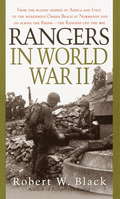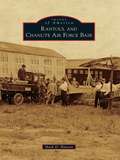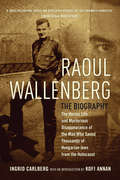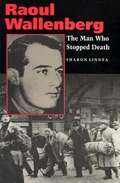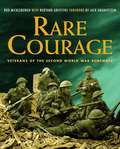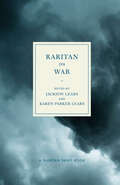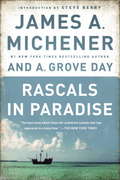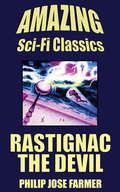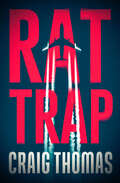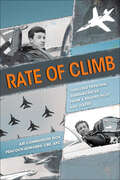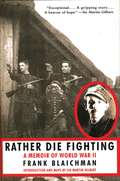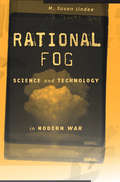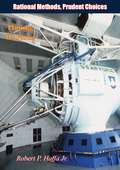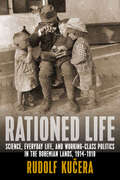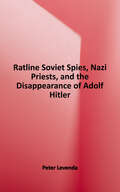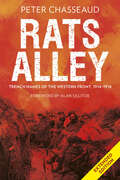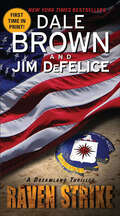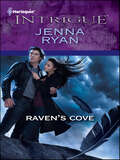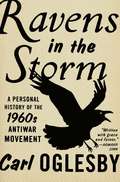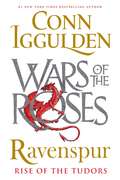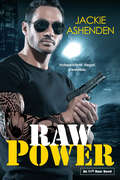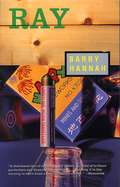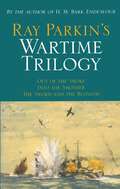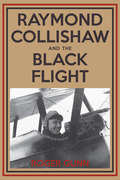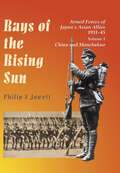- Table View
- List View
Rangers in World War II: Darby's Rangers In World War Ii
by Robert W. BlackFrom the deadly shores of North Africa to the invasion of Sicily to the fierce jungle hell of the Pacific, the contribution of the World War II Ranger Battalions far outweighed their numbers. They were ordinary men on an extraordinary mission, experiencing the full measure of the fear, exhaustion, and heroism of combat in nearly every major invasion of the war. Whether spearheading a landing force or scouting deep behind enemy lines, these highly motivated, highly trained volunteers led the way for other soldiers -- they were Rangers.With first-person interviews, in-depth research, and a complete appendix naming every Ranger known to have served, author Robert Black, a Ranger himself, has made the battles of WWII come to life through the struggles of the men who fought to win the greatest war the world has ever seen.
Rantoul and Chanute Air Force Base (Images of America)
by Mark D. HansonRantoul and the former Chanute Air Force Base are inseparably intertwined as primary players in a single historical narrative. Rantoul was first founded as an agriculturally based community in 1848 near an area known as Mink Grove. The settlement boomed with the coming of the Illinois Central Railroad in 1854; a railroad championed by the town's namesake, Robert Rantoul Jr. Disaster followed in 1899 and again in 1901 with devastating fires. Then, in 1917, a U.S. Army flying field was built on the outskirts of Rantoul. Named after the aviation pioneer Octave Chanute, Chanute Field, later Chanute Air Force Base, became a premier technical training facility. A mutually beneficial relationship quickly developed between these civilian and military establishments that would last for over 75 years. Chanute Air Force Base closed in 1993, ushering in yet another new era for the village of Rantoul.
Raoul Wallenberg: The Heroic Life And Mysterious Disappearance Of The Man Who Saved Thousands Of Hungarian Jews From The Holocaust
by Ingrid CarlbergAn Honorary Citizen of the United States and Canada, and designated as one of the Righteous among the Nations by Israel, Raoul Wallenberg was a modest envoy to Hungary whose heroism in Budapest at the height of the Holocaust saved countless Jewish lives, and ultimately cost him his own.A series of unlikely coincidences led to the appointment of Wallenberg, by trade a poultry importer, as Sweden's Special Envoy to Budapest in 1944. With remarkable bravery, Wallenberg created a system of protective passports, and sheltered thousands of desperate Jews in a special "international ghetto" created in collaboration with other neutral countries. As the war drew to a close, his invaluable work almost complete, Wallenberg voluntarily went to meet with the Soviet troops who were relieving the city. Arrested as a spy, Wallenberg disappeared into the depths of the Soviet system, never to be seen again.In this definitive biography, noted journalist Ingrid Carlberg has carried out unprecedented research into all elements of Wallenberg's life, narrating with vigor and insight the story of a heroic life, and navigating with wisdom and sensitivity the truth about his disappearance and death.
Raoul Wallenberg: The Man Who Stopped Death, First Edition
by Sharon LinneaThe book traces the life of the Swedish diplomat who saved Hungarian Jews during World War II and then mysteriously disappeared after the Russians occupied Budapest.
Rare Courage: Veterans of the Second World War Remember
by Rod Mickleburgh Rudyard GriffithsAn astonishing collection of compelling and vivid wartime memories. As Canada’s tens of thousands of veterans of the Second World War increasingly fall victim to the ravages of time, their personal stories become more and more vital to our understanding of what happened in those pivotal years. InRare Courage, twenty Canadian veterans candidly describe their experiences in their own words, combined with more than eighty photographs and artifacts from the Dominion Institute and the veterans’ personal collections. Rare Couragetakes readers to the sinking of theBismarckand to the bloody beaches of Normandy. It describes the poignant search of a Jewish nurse for survivors of the Holocaust and chilling tales of shot-down airmen on the run in occupied Europe. Many of the stories shed light on little-known aspects of the war: Did you know that almost all the pioneering radar officers on British warships were Canadians? Or that a Canadian major-league baseball star ended up a prisoner in Stalag Luft 13? This is not dry, academic history, but a book that breathes with vivid details. Rare Couragecelebrates the heroism and remembers the horror of the Second World War.
Raritan on War: An Anthology (Raritan Skiff Books)
by Michael Miller Robert Westbrook Andrew J. Bacevich Elizabeth D. Samet David Ferry Karl Kirchwey Tamas Dobozy Jochen Hellbeck Victoria De Grazia Sherod Santos Patrick Lawrence Lyle Jeremy Rubin C. Felix Amerasinghe M. Fortuna Cai Guo-Qiang Emma Dodge Hanson Ray Klimek Peter LaBier D. Mark LevittWe are, once again, a world at war. Geopolitical elites are deploying the implacable forces of ethnocentric hatred and religious nationalism; ordinary people are paying a fearful price. Not for the first time: this has been the characteristic pattern of war for more than a century. Every selection in this anthology (except for the timeless Aeneid) casts light on modern war, observed or directly experienced. Most are grounded in particular places—Stalingrad, Halberstadt, Budapest, Baghdad, Algiers, the Tamil ghost towns of Sri Lanka, the six-by-twelve-foot cell in Belmarsh maximum security prison where Julian Assange is held without bail for the act of revealing U.S. war crimes. Some recapture the actual look and feel of war—the sight of a seven-year-old girl clutching her mother's hand, dodging explosions in the Halberstadt public square; the sound of a Mozart concerto in D Minor, heard by a family hiding in a cave, played on their own piano by a Serbian sniper. Others take aim at the vast and vapid abstractions used to justify armed conflict, down to and including the use of nuclear weapons. Raritan on War collects some of the finest writing on that troubling subject published in Raritan Quarterly between 2003 and 2022. The editors, Jackson Lears and Karen Parker Lears, have selected work that typifies Raritan's wide-ranging sensibility, focusing on a topic that is aesthetically rich, intellectually challenging, and morally disturbing. Ultimately, Raritan on War reveals the power of art and reflection to sustain humane ways of being in the world, even amid constant global violence. Contributors: C. Felix Amerasinghe; Andrew J. Bacevich; Victoria De Grazia; Tamas Dobozy; David Ferry; M. Fortuna; Cai Guo-Qiang; Emma Dodge Hanson; Jochen Hellbeck; Karl Kirchwey; Ray Klimek; Peter LaBier; Patrick Lawrence; d. mark levitt; Michael Miller; Lyle Jeremy Rubin; Elizabeth D. Samet; Sherod Santos; Robert Westbrook
Rascals in Paradise: Turbulent Adventures and Bold Courage on the South Seas
by James A. Michener A. Grove DayIn a thrilling collection of nonfiction adventure stories, James A. Michener returns to the most dazzling place on Earth: the islands that inspired Tales of the South Pacific. Co-written with A. Grove Day, Rascals in Paradise offers portraits of ten scandalous men and women, some infamous and some overlooked, including Sam Costock, a mutinous sailor whose delusions of grandeur became a nightmare; Will Mariner, a golden-haired youth who used his charm to win over his captors; and Captain Bligh, the notorious HMS Bounty captain who may not have been the monster history remembers him as. From lifelong buccaneers to lapsed noblemen, in Michener and Day's capable hands these rogues become the stuff of legend. BONUS: This edition includes an excerpt from James A. Michener's Poland. Praise for Rascals in Paradise "The best book about those far-scattered islands that has appeared in a long time . . . a portfolio of rare and ruthless personalities that is calculated to make the curliest hair stand straight on end."--The New York Times "[Combines] research and scholarship (A. Grove Day was a professor at the University of Hawaii) with a gift for spinning a yarn and depicting character (Michener, journalist and novelist, needs no introduction)."--Kirkus Reviews
Rastignac the Devil
by Philip Jose FarmerAfter the Apocalyptic War, the decimated remnants of the French huddled in the Loire Valley were gradually squeezed between two new and growing nations. The Colossus to the north was unfriendly and obviously intended to absorb the little New France. The Colossus to the south was friendly and offered to take the weak state into its confederation of republics as a full partner.
Rat Trap
by Craig ThomasNew York Times–Bestselling Author: A hijacking at a London airport leads to a manhunt for an arms dealer as the clock ticks down to disaster . . . Engine troubles start just as the jet is approaching Heathrow. Then, after a harrowing landing, just as everyone breathes a sigh of relief, the hijackers rise up . . . Their demand: the release of arms smuggler Shafiq Nasoud from a British prison. Authorities decide to transport him to London in case the situation turns desperate—but things go very wrong. Nasoud escapes. Negotiations continue to fail. The hijackers&’ leader, an American, appears to be strung out on drugs—and the FBI gets in touch to share some deeply concerning information about another terrorist. Before it all ends, blood will be spilled—but whose? Praise for Craig Thomas&’s novels &“Will have you sweating bullets . . . Tension is sustained from first page to last.&” —The New York Times Book Review &“Lively, straightforward action.&” —Kirkus Reviews (starred review) &“The last word in espionage thrillers.&” —The Pittsburgh Press
Rate of Climb: Thrilling Personal Reminiscences from a Fighter Pilot and Leader
by Air Commodore Rick Peacock-EdwardsA veteran RAF fighter pilot reflects on his service in the sky during the Cold War, the Gulf War, and more in this exciting memoir.Rick Peacock-Edwards has led different lives at different times, but through it all, he has consistently enjoyed himself. One of three sons of outstanding South African Battle of Britain pilot F/O S R “Teddy” Peacock-Edwards, Rick has a compassionate regard for a generation of wartime aircrew: “As the proud son of one of the “Few,” their selfless daring has inspired me throughout my life. Importantly, they influenced my decision to become an airman in the Royal Air Force, to become a fighter pilot like my father, and to live life with spirit as they had lived their lives. It is essential that their experiences live on.” Rate of Climb, his original and entertaining biography, drawing on previously unpublished family and archival material, shows Rick in complete command of his primary subject: flying. A leading ex-RAF fighter pilot to his fingertips, he flew the Lightning, Phantom, Tornado F2/3 and other high-performance aircraft, and served in senior-ranking positions in the UK, Germany and the US. During a varied and distinguished career, he was closely associated with the Eurofighter Typhoon programme and was appointed as the Royal Air Force Inspector of Flight Safety. He ably demonstrated his uncommon skill and determined leadership during the Cold War era, first Gulf War and elsewhere. A past master of The Honourable Company of Air Pilots, he is a Fellow of the Royal Aeronautical Society and the immediate past vice chairman of the Royal Air Force Club in London. He is equally as engaged in his post-RAF career as he was when a serving officer. This is an action-packed account of a foremost flyer’s life with endless good stories, and a colourful cast of characters to match. Rick’s compelling recollections in Rate of Climb reveal a life of considerable achievement, in a very personal book capturing the ties of airmanship that the author has been privileged to share. A must for all lovers of derring-do in the air.
Rather Die Fighting: A Memoir of World War II
by Martin Gilbert Frank BlaichmanFrank Blaichman was sixteen years old when the war broke out. In 1942, the killings began in Poland. With his family and friends decimated by the roundups, Blaichman decided that he would rather die fighting; he set off for the forest to find the underground bunkers of Jews who had already escaped. Together they formed a partisan force dedicated to fighting the Germans. This is a harrowing, utterly moving memoir of a young Polish Jew who chose not to go quietly and defied the mighty German war machine during World War II.Skyhorse Publishing, along with our Arcade, Good Books, Sports Publishing, and Yucca imprints, is proud to publish a broad range of biographies, autobiographies, and memoirs. Our list includes biographies on well-known historical figures like Benjamin Franklin, Nelson Mandela, and Alexander Graham Bell, as well as villains from history, such as Heinrich Himmler, John Wayne Gacy, and O. J. Simpson. We have also published survivor stories of World War II, memoirs about overcoming adversity, first-hand tales of adventure, and much more. While not every title we publish becomes a New York Times bestseller or a national bestseller, we are committed to books on subjects that are sometimes overlooked and to authors whose work might not otherwise find a home.
Rational Fog: Science And Technology In Modern War
by M. Susan LindeeA thought-provoking examination of the intersections of knowledge and violence, and the quandaries and costs of modern, technoscientific warfare.Science and violence converge in modern warfare. While the finest minds of the twentieth century have improved human life, they have also produced human injury. They engineered radar, developed electronic computers, and helped mass produce penicillin all in the context of military mobilization. Scientists also developed chemical weapons, atomic bombs, and psychological warfare strategies.Rational Fog explores the quandary of scientific and technological productivity in an era of perpetual war. Science is, at its foundation, an international endeavor oriented toward advancing human welfare. At the same time, it has been nationalistic and militaristic in times of crisis and conflict. As our weapons have become more powerful, scientists have struggled to reconcile these tensions, engaging in heated debates over the problems inherent in exploiting science for military purposes. M. Susan Lindee examines this interplay between science and state violence and takes stock of researchers’ efforts to respond. Many scientists who wanted to distance their work from killing have found it difficult and have succumbed to the exigencies of war. Indeed, Lindee notes that scientists who otherwise oppose violence have sometimes been swept up in the spirit of militarism when war breaks out.From the first uses of the gun to the mass production of DDT and the twenty-first-century battlefield of the mind, the science of war has achieved remarkable things at great human cost. Rational Fog reminds us that, for scientists and for us all, moral costs sometimes mount alongside technological and scientific advances.
Rational Methods, Prudent Choices: Planning US Forces
by Robert P. Haffa Jr.Planning for US military forces goes on regardless of the political party in power, the state of the budget, or the issues of the moment. Because planners decide the size and shape of land, air, and sea forces, force planning is at the very core of our national security effort. In this primer on force planning, Colonel Robert P. Haffa reviews the process used to structure our strategic, general purpose, and rapidly deployable forces. He contends that many people both within and outside the defense community do not fully understand force planning methods. Too often, he writes, military planners themselves—caught up in the daily pressures of the bureaucracy—focus on parochial, near-term issues. At the national level, far too many public debates are cast in terms of dollars instead of national objectives, missions, and forces. Haffa calls for a return to first principles, recommending these four guidelines for force planning: emphasize coherent policy relationships; rely on empirical data; stress planning, not budgeting consider the long term. Haffa shows that rational planning methods lead to prudent choices. His analysis reminds force planners never to lose sight of fundamentals, especially while prodding national leaders to pay attention to the rational methods of force planning. This fresh study of how we plan our military forces inspires us to get back to the basics essential for informed, productive debate on defense issues. Bradley C. Hosmer Lieutenant General.
Rationed Life: Science, Everyday Life, and Working-Class Politics in the Bohemian Lands, 19141918
by Rudolf KučeraFar from the battlefront, hundreds of thousands of workers toiled in Bohemian factories over the course of World War I, and their lives were inescapably shaped by the conflict. In particular, they faced new and dramatic forms of material hardship that strained social ties and placed in sharp relief the most mundane aspects of daily life, such as when, what, and with whom to eat. This study reconstructs the experience of the Bohemian working class during the Great War through explorations of four basic spheres-food, labor, gender, and protest-that comprise a fascinating case study in early twentieth-century social history.
Ratline: Soviet Spies, Nazi Priests, and the Disappearance of Adolf Hitler
by Peter LevendaRatline is the documented history of the mechanisms by which thousands of other Nazi war criminals fled to the remotest parts of the globe - including quite possibly Adolf Hitler. It is a story involving Soviet spies, Nazi priests, and a network of Catholic monasteries and safe houses known as the rat line. The name of one priest in particular, Monsignor Draganovic, was discovered by the author in a diary found in Indonesia. Why would this name turn up in a document written in a spidery German hand on a remote island in Indonesia? As famed author Peter Levenda began his research, more information came to light: In December of 2009, it was revealed that the skull the Russians claimed was Hitler's - salvaged from the bunker in 1945 - was not that of Hitler! In 2010, files from the Office of Special Investigations of the Justice Department were declassified, revealing a history of American intelligence providing cover for Nazi war criminals. The mystery deepened, and the author returned to his own roots hunting Nazis in North America, South America, and Europe. He revisited old contacts and made some new ones, and gradually the explosive story was revealed: there is no forensic evidence to prove that Adolf Hitler died in the bunker in April 1945!
Rats Alley: Trench Names of the Western Front, 1914–1918
by Alan Sillitoe Peter ChasseaudWhen first published in 2006, Rats Alley was a ground-breaking piece of research, the first-ever study of trench names of the Western Front. Now, in this fully updated and revised second edition, the gazetteer has been extended to well over 20,000 trench names, complete with map references – in itself an essential tool for any First World War researcher.However, combined with the finely considered history and analysis of trench naming during the First World War, this is an edition that no military history enthusiast should be without. Discover when, how and why British trenches were first named and follow the names’ fascinating development throughout the First World War, alongside details of French and German trench-naming practices.Looked at from both contemporary and modern points of view, the names reveal the full horror of trench warfare and throw an extraordinary sidelight on the cultural life of the period, and the landscape and battles of the Western Front. Names such as Lovers Lane, Idiot Corner, Cyanide Trench, Crazy Redoubt, Doleful Post, Furies Trench, Peril Avenue, Lunatic Sap and Gangrene Alley can be placed in context.With useful information on where original trench maps are held, and how to obtain copies, Rats Alley is a vital volume for both military and family historians.
Raven Strike: A Dreamland Thriller (Dreamland Thrillers #13)
by Dale Brown Jim DeFeliceNew York Times–Bestselling Authors: These CIA operatives are on a mission in the Sudan that’s classified—and illegal . . . In the blistering heat of the Sudan, the CIA has gone rogue. On the trail of a notorious terrorist, Agency operatives have overstepped their sanctioned boundaries. And now the ultimate weapon has fallen into the wrong hands.As Danny Freah and his spec-ops team scramble to recover a top-secret aircraft that has crashed in Africa, Whiplash Director Jonathon Reid finds himself mysteriously shut off from information about the robot drone and its mission. Maneuvering through the twisted back corridors of the CIA and Washington’s power elite, Reid discovers secrets both illegal and highly dangerous—a virtually unstoppable assassin and an out-of-control clique within the Agency.Torn between loyalty and conscience, Reid must find a way to alert the president and avert a national disaster. But with the Whiplash team caught in the chaos of a brutal African civil war and CIA officials desperate to keep Reid from telling what he knows, a monster re-emerges to target its creators . . .Praise for Dale Brown“The best military adventure writer in the country.” —Clive Cussler“The novels of Dale Brown brim with violent action, detailed descriptions of sophisticated weaponry, and political intrigue . . . His ability to bring technical weaponry to life is amazing.” —San Francisco Chronicle
Raven's Cove
by Jenna RyanThe reappearance of Rogan signaled she needed protection. They'd lived together for months in a safe house, her life in this mysterious detective's hands. Dark haired and heavyhearted, Rogan had allowed his and Jasmine's fates to be intertwined, just as someone from her past sought to kill her....Rogan and Jasmine had ended their romance because of the danger it had brought. Now, if they hoped to stop the killer, they would have to revisit Raven's Cove, the birthplace of the ancient legend he twisted to suit his dark mission. And uncover the secrets still left between them...
Ravens in the Storm: A Personal History of the1960s Antiwar Movement
by Carl OglesbyIn 1964, Carl Oglesby, a young copywriter for a Michigan-based defense contractor, was asked by a local Democratic congressman to draft a campaign paper on the Vietnam War. Oglesby's report argued that the conflict was misplaced and unwinnable. He had little idea that its subsequent publication would put him on a fast track to becoming the president of the now-legendary protest movement Students for a Democratic Society (SDS). In this book, Oglesby shares the triumphs and tribulations of an organization that burgeoned across America, only to collapse in the face of surveillance by the U.S. government and infighting. As an SDS leader, Oglesby spoke on the same platform as Coretta Scott King and Benjamin Spock at the storied 1965 antiwar demonstration in Washington, D.C. He traveled to war-ravaged Vietnam and to the international war crimes tribunal in Scandinavia, where he met with Jean-Paul Sartre and Simone de Beauvoir. He helped initiate the Venceremos Brigade, which dispatched thousands of American students to bring in the Cuban sugar harvest. He reluctantly participated in the protest outside the 1968 Democratic National Convention and was a witness for the defense at the trial of the Chicago Seven the following year. Eventually, after extensive battles with those in SDS who saw its future more as a vanguard guerrilla group than as an open mass movement, Oglesby was drummed out of the organization. Shortly after, it collapsed when key members of its leadership quit to set up the Weather Underground. This beautifully written and elegiac memoir is rich in contemporary echoes as America once again must come to terms with an ill-conceived military adventure abroad. Carl Oglesby warns of the destructive frustrations of a peace campaign unable to achieve its goals. But above all, he captures the joyful liberation of joining together to take a stand for what is right and just -- the soaring and swooping of a protest movement in full flight, like ravens in a storm.
Ravenspur: Rise Of The Tudors (War Of The Roses Ser. #4)
by Conn IgguldenWitness the rise of the Tudor dynasty—in this concluding volume to Conn Iggulden’s vigorous and commanding retelling of the Wars of the Roses. England, 1470. A divided kingdom cannot stand. King Edward of York has been driven out of England. Queen Elizabeth and her children tremble in sanctuary at Westminster Abbey. The House of Lancaster has won the crown, but York will not go quietly. Desperate to reclaim his throne, Edward lands at Ravenspur with a half-drowned army and his brother Richard at his side. Every hand is against them, every city gate is shut, yet the brothers York go on the attack. But neither sees that their true enemy is Henry Tudor, now grown into a man. As the Red Dragon—“the man of destiny”— his claim to the throne leads to Bosworth Field and a battle that will bring an end to the Wars of the Roses . . .
Raw Power (An 11th Hour Novel #1)
by Jackie AshendenThey fought for their country. Now they fight for you. To find the people lost in the shadows, you need the men who live in them. The former soldiers of 11th Hour are unaffiliated, unacknowledged, and definitely illegal. They protect the innocent, destroy the guilty—and capture hearts along the way . . . Rugged, skilled, and hard-bodied, Jack King’s whole life was the Marines until an injury left him discharged from active duty. But he finds a new purpose when he’s recruited by a special unit that employs ex-military to do very special jobs. Yet he’s not impressed when his first assignment is babysitting the pretty, perfect daughter of a politician—especially when she’s far from the angel she appears to be . . . Callie Hawthorne hates politics, and she hates playing the part of a senator’s goody two shoes daughter even more. It only gets worse when her father decides she needs a security detail 24/7—and the bodyguard happens to be the most insanely hot guy Callie’s ever seen. Still, she’s not going to be ordered around just because of some half-assed threat to her father. . . . But when it turns out her dad’s no angel either, Jack has to kidnap Callie in order to protect her. And as danger closes in, he’ll need all his considerable talents to keep them both alive. The greater challenge will be to keep his hands off her . . . Praise for Jackie Ashenden’s Dirty for Me “An intense scorcher of a story that is sure to delight fans and win her a legion of new devotees. . . . Unforgettable.” —RT Book Reviews, Top Pick “Tension and heat pervade the frequent sex scenes . . . Readers will eagerly anticipate future installments in the series.” —Publishers Weekly “Explosively sexy.” —Heroes & Heartbreakers
Ray
by Barry HannahNominated for the American Book Award, 'Ray' is the bizarre, hilarious, and consistently adventurous story of a life on the edge. Dr. Ray-- a womanizer, small-town drunk, vigilante, poet, adoring husband-- is a man trying to make sense of life in the twentieth century. In flight from the death he dealt flying over Vietnam, Dr. Ray struggles with those bound to him by need, sickness, lunacy, by blood and by love.
Ray Parkin's Wartime Trilogy
by Ray ParkinThese brilliant books hum with action, adventure and courage. Honestly and plainly written, they are full of humanity and great wisdom. Out of the Smoke tells of Ray's experiences as Action Chief Quartermaster in HMAS Perth, which was sunk while engaging an overwhelming Japanese naval force in the Sunda Strait. Two cruisers, HMAS Perth and USS Houston, fought until their ammunition was exhausted. Thus defenceless and surrounded, sunk by four torpedoes and gunfire. It had been a night action, desperate and determined until the inevitable end. A small party of the survivors tried to sail a derelict lifeboat to safety, only to land at a port in enemy hands. In his Introduction to the book, Sir Laurens van der Post describes Out of the Smoke as 'one of the great stories of war at sea'. Into the Smother tells, direct from the author's diary, of his fifteen months as a POW on the Burma-Siam {Thailand} railway. The construction of this railway remains one of history's most awful instances of man's inhumanity to man. Ray documents with remarkable restraint the horrors and sufferings he and his comrades endured at the mercy of the cruel jungle and the Imperial Japanese Army. The book has an appendix by Sir Edward 'Weary' Dunlop, to whose care Ray had entrusted his secret writings, drawings and paintings when taken to Japan. Into the Smother is impressive in its honesty and inspiring in its evocation of courage and endurance. The Sword and the Blossom tells of Ray's last twelve months of captivity. Shipped to Japan in an incredibly crowded, derelict tramp steamer, he and his comrades endured submarine attacks and weathered a typhoon with open hatches. They were then taken to a POW camp at Ohama, on the shores of Honshu, where they worked in a coal mine under the Inland Sea. With the dropping of the atomic bombs on Hiroshima and Nagasaki—one just to the north of them, the other just to the south-the POWs found themselves free among a people who had held over them the power of life and death. The Sword and the Blossom gives the reader a remarkable insight into the Japanese way of thinking, and lights the ghastly experience with magnificent prose. These classic books are illustrated with Ray Parkin's evocative and detailed drawings and sketches, made secretly at the time.
Raymond Collishaw and the Black Flight
by Roger GunnThe first comprehensive biography of Canada’s third-highest- scoring ace in the First World War. Ever wondered what it would be like to fly a biplane or triplane in the First World War? Raymond Collishaw and the Black Flight takes you to the Western Front during the Great War. Experience the risks of combat and the many close calls Collishaw had as a pilot, flight commander, and squadron leader. Understand the courage Collishaw and his fellow flyers faced every day they took to the air in their small, light, and very manoeuvrable craft to face the enemy.As the third-highest-scoring flying ace among British and colonial pilots in the First World War, scoring 60 victories, Collishaw was only surpassed by Billy Bishop and Edward Mannock. This book traces Collishaw’s life from humble beginnings in Nanaimo, British Columbia, to victories in the skies over France.
Rays of the Rising Sun: Armed Forces of Japan's Asian Allies 1931-45: China and Manchukuo (Rays Of The Rising Sun Ser. #Vol. 1)
by John Berger Philip JowettThe first of a three-volume series examining the history of Chinese “puppet” soldiers fighting for the Japanese before and during World War II.When the Japanese Empire went to war with the Allies in December 1941. it had already been fighting in China for 10 years. During that time, it had conquered huge areas of China, and subjugated millions of people. The Japanese needed to control the Chinese population in these occupied territories, and for this reason they set up governments from amongst the leaders of the Chinese who were willing to co-operate with them. These so-called “puppet” governments were designed to rule on behalf of the Japanese while firmly under their control. In turn, the “puppet” governments needed their own armed forces to help them maintain control over the populace and so they raised their own 'independent' armed forces. These “puppet” armies were in large number, reaching a total of well over 1 million before 1945. Although poorly armed and equipped, these forces had an influence on the Japanese war effort through sheer numbers.The Chinese “puppet” soldiers ranged from the well-drilled and trained regular Army of the Last Emperor of China, Pu Yi, who ruled the newly formed state of Manchukuo, 1932–45, to the irregular Mongol cavalry who served alongside Japanese troops in the “secret war” waged in the Mongolian hinterlands.The troops were dismissed as traitors by the Chinese fighting the Japanese, and they were equally despised by the Japanese themselves. The troops were motivated by a range of reasons, from simple survival to a loyalty to their commander. The fact that so many Chinese were willing to fight for the Japanese was embarrassing to all sides, and for this reason has been largely ignored in previous histories of the war in the East. In the first of a three-volume series, Philip Jowett tells the story of the Chinese who fought for the Japanese over a fourteen-year period.
